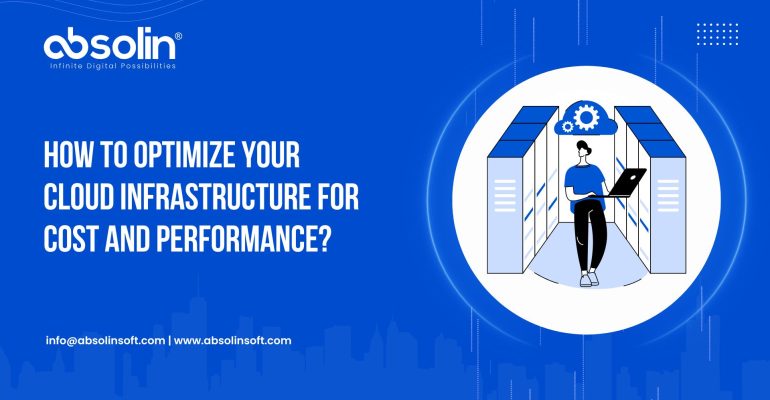How to Optimize Your Cloud Infrastructure for Cost and Performance?
When organizations complain about humongous cloud bills or sluggish applications, they often frame it as a problem. But here’s a secret: what looks like a problem is usually an untapped opportunity in disguise.
Think of cloud infrastructure like a high-performance sports car. It has incredible capabilities, but without tuning the engine, checking the fuel mix, and adjusting your driving style, you’ll never get the speed or mileage you expect. Worse, you might burn cash on unnecessary horsepower or leave performance potential on the table.
In most cases, businesses are over-provisioning, under-utilizing, or poorly architecting their cloud environments. The cloud promises scalability, elasticity, and efficiency—but only if you learn how to drive it right.
So let’s get into how you can optimize your cloud infrastructure—not just to save money, but to accelerate performance, reliability, and business outcomes.
1. Start with Visibility: Know What You Have
You can’t optimize what you can’t see. Many businesses deploy workloads and forget about them, leading to zombie resources eating up budgets.
Action Steps:
- Run a cloud inventory audit: Use tools like AWS Cost Explorer, Azure Advisor, or GCP Recommender to map out resources.
- Tag everything: Implement consistent tagging policies to group resources by department, project, or environment.
- Set budgets and alerts: Use cloud-native or third-party tools (like CloudHealth or Spot.io) to set thresholds and monitor spending.
Pro Tip: Create a centralized dashboard that updates in real-time to track utilization, costs, and performance KPIs.
2. Right-Size Your Resources
Overprovisioning is one of the most common causes of waste in cloud environments. Just because you can scale up doesn’t mean you should.
Optimization Tactics:
- Analyze CPU, memory, and disk utilization to identify underused resources.
- Use auto-scaling groups to dynamically adjust compute power.
- Experiment with burstable instances (like AWS T-series) for workloads with fluctuating demands.
Key Metric: Aim for 70-80% average utilization—this provides buffer without overkill.
3. Choose the Right Storage Solutions
Not all storage is created equal. Using high-performance SSDs for archived data is like using a Ferrari to deliver mail.
Best Practices:
- Match storage tiers to workload needs (e.g., hot, warm, cold storage).
- Implement lifecycle policies to automatically move data to cheaper storage over time.
- Leverage object storage like Amazon S3 with versioning and intelligent tiering.
Cost-Saver: Use infrequent access storage for backup and archival data to cut storage costs by up to 70%.
4. Leverage Reserved and Spot Instances
Pay-as-you-go models are flexible but expensive. For long-running or predictable workloads, reserved and spot instances offer huge savings.
How to Use:
- Purchase Reserved Instances (RIs) or Savings Plans for baseline capacity.
- Use Spot Instances for stateless, fault-tolerant workloads (e.g., data processing, testing).
Savings Tip: Mixing RIs, on-demand, and spot gives you a balanced cost-performance architecture.
5. Optimize Network Traffic and Architecture
Data transfer costs can sneak up fast, especially when traffic moves between regions or cloud providers.
Ways to Cut Costs:
- Minimize cross-region data transfers.
- Use Content Delivery Networks (CDNs) to reduce latency and egress costs.
- Set up VPC peering and private endpoints to avoid public internet routing.
Performance Gain: Faster data delivery = better user experience + lower bandwidth bills.
6. Go Serverless Where It Makes Sense
Serverless platforms (e.g., AWS Lambda, Azure Functions) offer automatic scaling and a pay-per-use model, which is perfect for unpredictable or intermittent workloads.
Ideal Use Cases:
- Event-driven functions
- APIs with inconsistent traffic
- Cron jobs, automation scripts
No infrastructure management = reduced ops overhead and faster time to market.
7. Automate and Orchestrate Everything
Manual processes slow down performance and lead to human error. Automation ensures efficiency, consistency, and cost control.
What to Automate:
- Infrastructure provisioning with IaC tools like Terraform or AWS CloudFormation
- Auto-scaling and shutdown policies
- Alerts for budget thresholds and performance anomalies
Game-Changer: Use CI/CD pipelines that integrate cost-aware testing and performance benchmarks.
8. Adopt FinOps for Cross-Team Accountability
FinOps (Financial Operations) bridges the gap between finance, engineering, and product teams to align cloud costs with business value.
Core FinOps Principles:
- Shared accountability
- Real-time reporting and showback
- Cost-per-feature or cost-per-customer tracking
Future-Proofing: FinOps helps your org scale cloud usage intelligently, not just rapidly.
9. Use AI/ML for Smart Optimization
Machine learning tools can identify inefficiencies humans miss and automate dynamic scaling based on real usage patterns.
Examples:
- AI-powered autoscaling policies
- Predictive analytics for workload spikes
- ML-driven security posture optimization
Platforms like Azure Automanage, AWS Compute Optimizer, and GCP Recommender already provide these features.
10. Review, Refactor, Repeat
Optimization isn’t a one-time project—it’s a continuous process. As workloads, tools, and business needs evolve, so should your cloud strategy.
Continuous Optimization Steps:
- Monthly cost-performance reviews
- Cloud architecture health checks
- Continuous performance testing
Conclusion: Smart Cloud = Strong Business
Optimizing your cloud infrastructure isn’t just about shaving a few dollars off your AWS bill. It’s about building a faster, leaner, more responsive business that’s ready for anything—whether it’s a surge in users, a pivot in strategy, or a new product launch.
In 2025 and beyond, the most successful companies will be the ones who don’t just use the cloud—they master it.
By taking control of your architecture, aligning spend with performance, and embracing intelligent automation, your cloud becomes more than a tool—it becomes your competitive edge.
Need help with a cloud audit or optimization roadmap? Absolin can help you pinpoint waste, boost performance, and align your infrastructure with your goals. Let’s optimize your cloud for growth.



